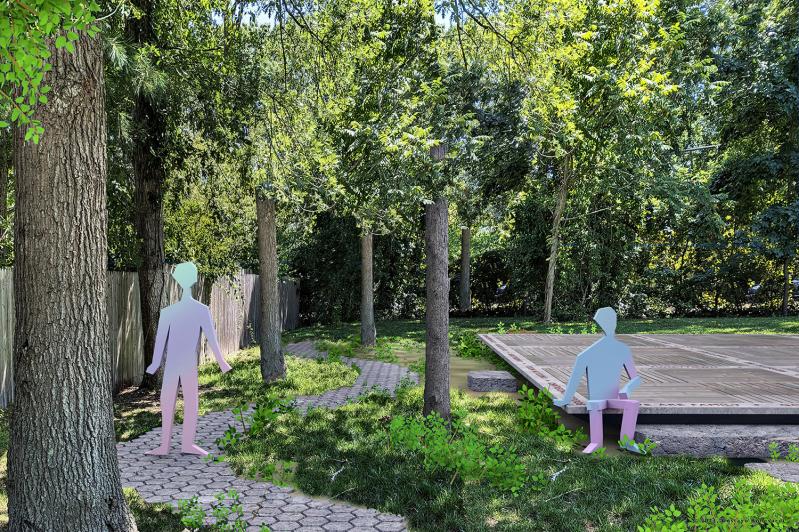The Wainscott Citizens Advisory Committee was enthusiastic about a proposal to transform Wainscott Green and connect past, present, and future with the creation of a “celebratory memorial” to the Swamp and the Annex, the nightclub and restaurant that stood for many years on the site.
Tom House, president of Hamptons Pride, and Gustavo Bonevardi, an artist and architect, discussed the latter’s preliminary design, which would incorporate symbols and music evoking the gay-liberation era of the 1970s, as well as the AIDS crisis that disproportionately impacted the gay community in the 1980s and 1990s.
The presentation came one month after plans for a picnic shelter on the green named for the late Rick Del Mastro, for which money is still being raised, were discussed at a committee meeting. Together, the shelter, the existing landscape design by Edwina von Gal, and the proposed memorial and historical markers are to coexist harmoniously in what is also known as the Rick Del Mastro Memorial Park.
Mr. Del Mastro, a civic activist and philanthropist who died in 2020, was a supporter of East Hampton Town’s effort to buy the 1.1-acre property, which it did for preservation purposes in 2018. The Swamp building was demolished, and four benches have since been donated and installed in the park.
When he learned that the site was to become a park, “it seemed such a golden opportunity to commemorate history, the generation in which the last and longest-running gay club and restaurant existed right on that spot,” Mr. House, a former bartender at the Swamp, told the committee. “There’s 25 years of L.B.G.T.Q.+ history here. A lot of us feel like it was a home for a long time.” The task, he said, “was to create and maintain an outdoor structure, a kind of historical marker, and a memorial all rolled into one. It was a big undertaking, and also a project that needed to please a lot of different people.”
Mr. Bonevardi, who said he was a patron of the Swamp, showed renderings depicting a low stone wall and, behind it, a “reconstructed” dance floor based on the building’s original plans, which featured a raised bar and sunken dance floor delineated by a diagonal line. Four bronze markers, each three inches in diameter and featuring the Swamp’s logo, have been placed in the ground marking the four corners of the structure.
The diagonal line, forming two triangles, “was part of the identity” of the Swamp, which was open from 1977 to 2001, Mr. Bonevardi said. “This triangle was a major feature. It lends itself perfectly to the idea of reconstructing the dance floor.” It “nestles perfectly” with the path on the property “and even complements it and seems to work with it.”
Mr. Bonevardi suggested an elevated dance floor constructed of wood and stone or precast concrete, the latter inscribed with the titles of songs popular in the Swamp’s halcyon days. “These are the songs that were listened to while people were dancing,” he said. “As you’re walking around, you read these titles, the melodies come back to your head, and you’re almost hearing the songs that were playing.”
For historical markers, Mr. Bonevardi said he is working on a means to depict the ubiquitous mirror balls of a discotheque, suggesting a configuration akin to stacked cannonballs, such as exist at war memorials, to conjure the triangle “which was such an important graphic logo” used by groups like ACT UP (the AIDS Coalition to Unleash Power).
The triangle became a symbol, Mr. House said, of “trying to save lives, trying to get people to confront the crisis that was happening in the gay community. So it is something that needs to be seen.”
A memorial path would be “a more contemplative area, a quieter, more relaxed part,” Mr. Bonevardi said. “There would be the opportunity to have engraved stone markers on the ground to acknowledge different individuals that have passed.” A QR code on the site would link to a website offering historical context and, perhaps, some of the songs featured on the dance floor.
All, he said, would fit with the park’s existing trees, which he hoped would be supplemented with more “to create as shaded and protected an area as possible. That would be the ‘gathering space’ aspect of it.”
“I personally think this is just a magical space,” Carolyn Logan Gluck, the committee’s chairwoman, said of the proposal. “I think this is terrific for many reasons, one of which is because it’s a very joyful place.”
Committee members were supportive of the concept as well, with the exception, for some, of the “cannonballs,” which one found “unrelated to the rest of it.” Councilwoman Sylvia Overby, the town board’s liaison to the committee, suggested a pyramid instead of cannonballs, which to her conjure “going to war,” she said. But she agreed with Ms. Logan Gluck that “the idea of the song titles is just perfect. I think that does . . . bring you back to that era and how important it was.”
“The reason for the Swamp was to dance, to have a safe haven, to have a community,” Mr. House said. “So we want that to be foremost. I think the design really reflects that.”
“We think of the design foremost as a social area that unites the present and future East End L.G.B.T.Q.+ people and their allies with their gay and lesbian forebears of the ’70s, ’80s, and ’90s,” he said after the meeting. “And at the same time a historical marker, as it is built inside the four corners of the old club, which thrived there for a generation.”
Ms. Logan Gluck asked for and received a motion from the committee approving the presentation of the plan by Mr. House and Mr. Bonevardi to the town board at an upcoming work session, with the understanding that the design is preliminary and will be modified as needed to comply with applicable laws, such as the town code and the Americans With Disabilities Act.
For the picnic shelter, $32,250 has been raised, with another $6,550 needed. Those wishing to donate to the purchase and installation can send a check to the Friends of Georgica Pond Foundation, P.O. Box 1393, Wainscott 11975, with “Wainscott Green Park” on the memo line. Donations can also be made at friendsofgeorgicapond.org/donate.




